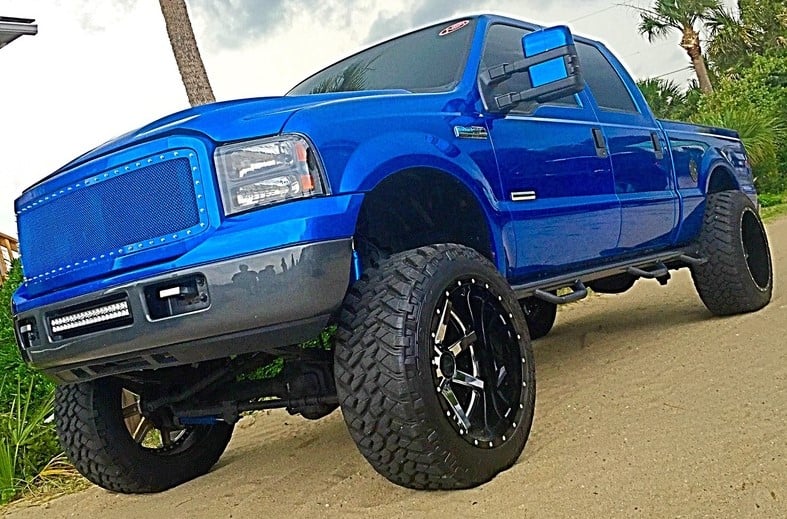Sign up now to join the JEGS email newsletter and be the first to learn about new products, special deals and e-mail only offers!

A mud tire looks like it should do well in snowy conditions because you’d think all those knobs should grip well, but are all knobby tires created equal? In today’s marketplace, you can find a tire for every application, but is it possible to use one type of tire for multiple applications? Let’s look at the design features that differentiate mud and snow tires to answer whether mud tires are good in snow.
Mud tires enhance traction and durability in dirt, gravel, mud, and rocky conditions. Several attributes improve their effectiveness in this role but may reduce their value on the road or in winter.
Most mud terrain tires have an aggressive tread pattern with deep lugs and wide spaces between the lugs. The deep lugs allow the tire to claw its way through mud or dirt, while the large spaces between the lugs enhance the tire’s ability to expel mud or other debris as the tire rotates, maintaining better traction over loose surfaces.
Many mud terrain tires also have lugs that extend onto the sidewall to provide extra grip and protection in deep ruts or rocky conditions.
Off-road users punish their tires, so a good mud tire needs to be built to withstand the rigors of the trail. If most of your trail driving is far from civilization, you want confidence that your tires will last for the ride and get you home safely. Some design features that improve mud tire durability include:
Combining multiple plies and a slightly softer rubber can provide the sweet spot between durability and grip.
The aspect ratio is the relationship between the width and sidewall height of the tire, so the higher the aspect ratio on your tires, the taller the tire's sidewall. Folks love the low-profile look of large rims with low aspect ratio tires, but on the trail, a higher aspect ratio can provide the flexibility to conquer tougher terrain and protect your rims. A higher aspect ratio also gives more room to air down your tires for additional traction, so you’ll typically see tires with higher aspect ratios on the trails.
The tire's bead is the area that maintains contact with the wheel rim, and it’s a critical piece of every mud terrain tire. Off-road enthusiasts often run extremely low pressures in their tires, even down to single-digit PSI, for added pliability and traction in challenging trails, putting a lot of strain on the bead.
Maintaining a good air seal at those low pressures requires reinforced beads that won’t deform with the rest of the tire. Some wheel and tire combinations even utilize a bead lock, which bolts the bead in place to maintain a proper seal, even at extremely low pressure.
Sign up now to join the JEGS email newsletter and be the first to learn about new products, special deals and e-mail only offers!

Are mud terrain tires good in snow? We’ve looked at some of the main design features of a mud tire, but are snow tires built differently?
Some similarities exist between the tread designs found on a mud tire and a snow tire. Compared to summer or all-season tires, a deeper tread block is common on both. In winter driving, the deep grooves in the tread block allow the tire to evacuate snow and slush as you drive.
Some of the highest-rated snow tires on the market have a V-shaped tread, whereas most mud terrain tires tend to have a blockier tread pattern. Other winter tires incorporate multiple tread patterns to enhance traction over various road conditions.
The rubber compound found in mud terrain tires will tend to be softer than compounds used in all-season tires, but a winter tire will have an even softer rubber, giving it a bit of extra stick when the weather drops below freezing. This is a considerable advantage when driving in snowy or icy conditions. However, that soft rubber will wear extremely quickly if you leave it on your vehicle once the weather is warmer.
One crucial difference between a mud tire and a snow tire is the extensive use of sipes in snow tires. Sipes are tiny cuts in the tire's tread block that allow the tread block to flex under pressure as you drive down the road, maintaining more tread contact with the road surface and improving traction. The sipes also provide a channel for moisture to dissipate so that your rubber contacts more pavement and less water.
Your tires are the primary contact between your vehicle and the road or trail, so investing in the correct tires for safety and performance benefits is essential. Finding the best mud tires for snow is difficult since each tire type is specifically designed for driving conditions and purposes.
Suppose you live in a region that experiences prolonged periods of snow and below-freezing temperatures. In that case, you should invest in a good set of snow tires for the winter season. However, be sure to swap them out when the weather gets warmer, or you’ll find that they will experience higher rates of wear due to the softer rubber compound found in a winter tire.
Typically, snow-rated tires are referred to as winter tires, and you can identify them by the symbols stamped on the sidewall. A certified winter tire will have the three-peaked mountain snowflake icon stamped on the side of the tire.
Whatever tire style you settle on, JEGS has the right set for you. Find top brand names in stock in a wide range of sizes, and our experts are on hand to help match you with the tires you need.



